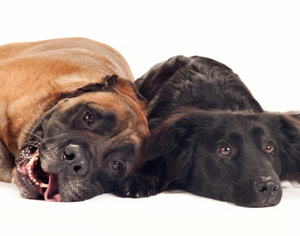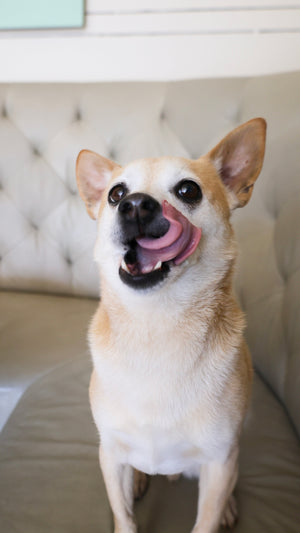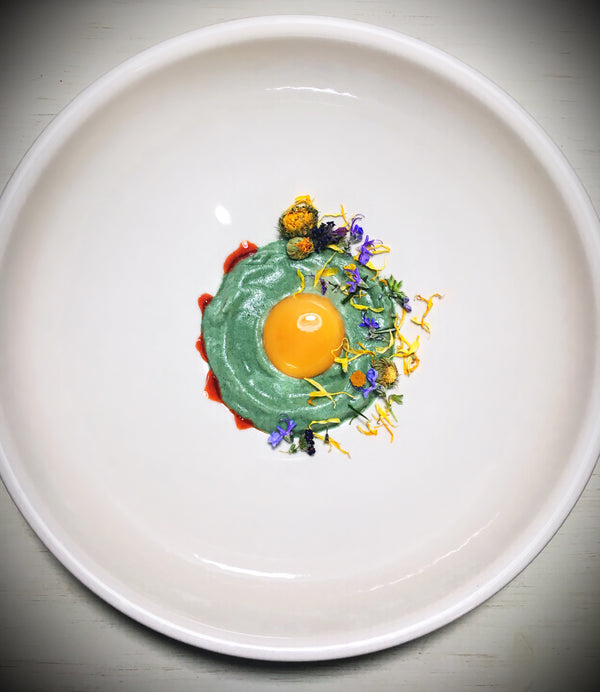WE'RE HERE TO HELP
We understand this can be a scary transition. That's why we're here to help! Below you will find everything you need to know about feeding raw, how to transition your dog, and what symptoms to look out for. For any ongoing symptoms please consult your veterinarian.
THE TRANSITION TO FRESH FOOD
A FEEDING GUIDE
There are two methods we suggest. You can choose which works best for you: gradual switch or full switch.
It is important to note that some digestive discomfort is common with both methods during early transition stages and will go away in time.
The duration is dependent on age, disease, overexposure to toxins and chemicals, and a lifetime of eating kibble. We suggest adding a naturally probiotic rich goat kefir to help boost gut health during this time.
*If symptoms like diarrhea or vomiting persist for longer than a few days it is best to seek the care of your veterinarian for underlying health issues.
FULL SWITCH
Eliminate dog's current food and begin a 12-24 hour fast to purge their digestive tract. Then start with a 1/2 portion to assess tolerance. If accepted well, feed the other half later that same day.
**It’s important to note if you are transitioning a puppy you should only fast them for one meal and feed the next meal a little earlier than usual. Do not fast your puppy for an extended period of time.
***If you have an older dog who has been eating processed food for years, digestive upset is common and may occur in the early stages, this should go away soon.
THE GRADUAL APPROACH
During the first 7-14 days of feeding, start with a small portion of fresh food (roughly 1/8-1/4 of their standard meal) and increase this portion size gradually until it is well tolerated.

NATURAL PURGING PROCESS
During the detoxification process, there is a lot going on within the body. You may notice flu-like symptoms that may seem to be getting worse before they get better. This is normal and very common in the early stages of a fresh-food transition. Don’t be discouraged!! These symptoms are temporary and part of the process to creating better health for your dog. A few reported symptoms to be aware of are:
- Shedding more than normal
⁃ Flakey, itchy skin
⁃ Irritated paws and ears
⁃ Joint stiffness
⁃ Diarrhea or loose stools
⁃ Mucus coated stools
⁃ Low energy level
⁃ Smelly breath and body odor
⁃ Goopy eyes

FASTING
Have you ever noticed from time to time that your dog just won’t eat their meal? It may be a single meal, a whole day or even a few days. In fact, this is a normal phenomena. If we follow the natural diet of a dog, their feeding cycles often follow a rhythm. Some days they hunt and gorge on a huge meal, the next they may still be satiated and won’t eat. Perhaps the next day doesn’t allow for a consistent supply of game to hunt, so they opportunistically scavenge whatever they may find. The feeding cycle is one of feast and famine.
These natural breaks in eating give the digestive system a much needed reset and allow the body time to recover, rebalance, and regenerate other systems. It is worth considering implementing this natural practice. Help with the addition of health boosting situations by subtracting digestive workload.
Speak with your veterinarian to assess the benefits of fasting your dog before implementing any changes. Once you and your veterinarian have assessed the health of your dog, consider adding a fast day from time to time. We like to pick a day and implement a simulated hunt and fast cycle. Feed a ‘gorge’ meal, mimicking a large hunt and fast the next day. This doesn’t have to be an all or nothing approach. A 12-24 hour fast while offering fresh water, bone broth, and kefir will give the digestive system a much needed break and will have an impact on overall wellness.
FAST DAY OPTIONS:
- 12-24 hours once a month will offer benefits and won’t overwhelm you or your dog.
⁃ On fast days always allow access to plenty of fresh water. You may consider offering bone broth, a protein, and mineral rich treat your dog is sure to enjoy.
⁃ Kefir, a fermented milk made from cow, goat or sheep, is loaded with gut boosting probiotics. It’s important to note many dogs may suffer intolerances to specific types of dairy (just like humans). We suggest raw goat milk kefir as it’s well tolerated by most dogs.
⁃ Fruits and vegetables in small amounts if tolerated.
⁃ Fat is a good option to feed in small amounts as well. Raw grass fed butter, tallow, ghee, and coconut oil when fed in small amount are a good treat.
⁃ You may also simply offer nothing but water. If choosing this approach it is worth considering a shorter fasting window.
*Please consult your veterinarian before experimenting with fasting options.

A WORD ABOUT BONES
While bones are incredible to add to your dog's diet, you should never give your dog cooked bones! When cooked, bones become brittle, break, splinter, and can injure your dog; especially if you have an enthusiastic chewer. When cooked, bones release moisture and minerals leaving just brittle calcium behind. This is what breaks and splinters.
Having said that, we believe recreational bones are one of the healthiest things you can offer your dog given you always supervise while chewing! Chewing on a bone offers many benefits like descaling dirty teeth, activating digestive systems to help process meals, and mental stimulation that satisfies them on a deep level.
Raw, meaty bones that have not been cooked are edible for dogs. Raw chicken, turkey, duck, lamb, and some beef bones are soft enough to chew, eat, and digest. They key to successfully feeding bones is to pick the right bones and to always supervise chew time.
Key points worth noting when feeding bones:
⁃ Always supervise chewing
⁃ Always offer raw bones, never cooked
⁃ Do not give bones to dogs who have had dental work or injured teeth
⁃ Pick bones that are non weight bearing. That means no femurs from large animals including those brown, smoked knuckle and leg bones often sold at pet and grocery stores
⁃ Offer bones that are longer than their muzzle making it unlikely for them to swallow
⁃ Don’t feed bones that can be swallowed whole
⁃ Offer after a meal as mental stimulation and a digestive aid
⁃ Refrigerate bones when chew time is over and throw out gnawed bones
*Most importantly speak with your veterinarian before implementing any dietary changes



